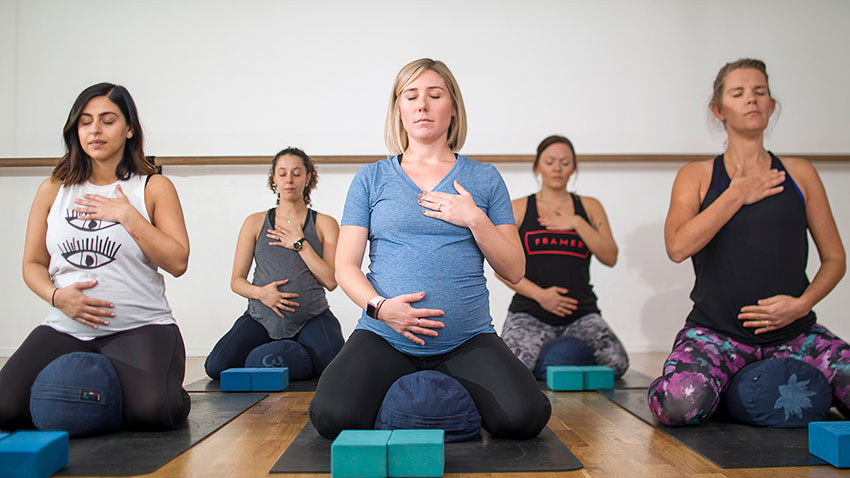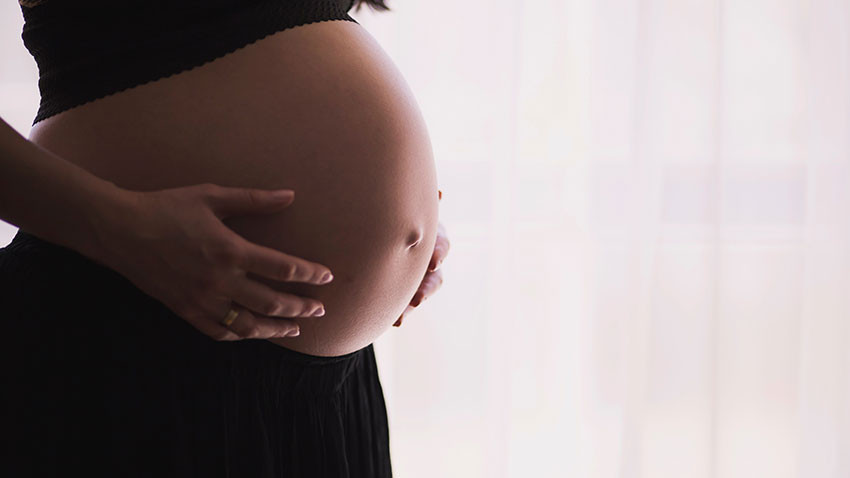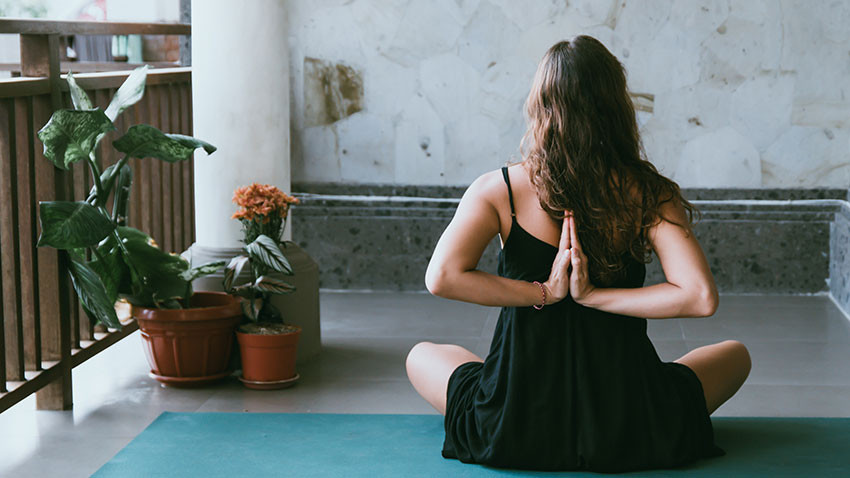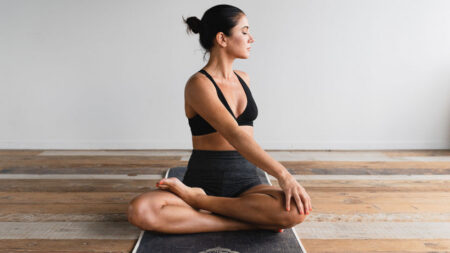How safe it is to practise and what postures you should avoid with a bump
So you’re hoping to practise yoga with your growing bump, but are worried about how to stay safe on the mat. Whether you were a yogi before getting pregnant and want to learn how to adapt your postures, or are totally new to yoga but have heard about the benefits of prenatal practise, here’s what you need to know about pregnancy yoga.
What are the benefits of practising yoga during pregnancy?
Sure, it’s a time when you might want to stay tucked up on the sofa watching Netflix, but staying fit during pregnancy is important for you and your baby. According to the NHS, “the more active and fit you are during pregnancy, the easier it will be for you to adapt to your changing shape and weight gain. It will also help you to cope with labour and get back into shape after the birth.”
- Read more: The best maternity yoga pants
Emma Greenough, a pregnancy yoga teacher at MumHood by Frame, explains how the benefits of practising yoga during pregnancy go beyond a woman’s general fitness. First she addresses one of pregnancy’s most common myths – that you need to sleep more during pregnancy to get ready for your baby’s arrival. “Sleep in pregnancy can be uncomfortable and difficult, particularly in the third trimester, and yoga really helps to alleviate this by calming the nervous system and resetting the body, encouraging a deeper sleep.”

As well as reducing stress and anxiety, pregnancy yoga can help a woman prepare for birth; “pregnancy yoga offers some tools for a mum-to-be to be able to take into labour including breathing exercises and visualisations that help to make it a calmer experience” explains Greenough. “The physical benefits include strength, flexibility and endurance of muscles needed for childbirth. Yoga can also help to alleviate lower and upper back pain and open into the hops and shoulders, which are common hotspots during pregnancy”, says Greenough.
If a woman hasn’t practised yoga before falling pregnant, can she start during pregnancy?
The NHS recommends that women keep up their normal exercise routine and avoid trying anything new during pregnancy, but does this apply to yoga too? According to Greenough, not necessarily; “I’d recommend she attends yoga classes specifically for pregnancy with a specially trained teacher.” Pregnancy isn’t the time to start practising at home on your own if you’ve never been on the mat before, but pregnancy yoga classes are often widely available, and the teacher will be able to guide you through postures safely.
If you are pregnant and worried about your exercise routine, it’s a good idea to talk to your GP or midwife before attending a class.
What yoga poses aren’t safe during pregnancy?
If you are a practising yogi, knowing which postures to avoid during pregnancy is important. Greenough explains that while there are plenty of modifications and options for women practising yoga during pregnancy, it is still a good idea to make the instructor aware before the class, so they can ensure you’re safe.

When it comes to postures to avoid, the list includes:
Closed twists: For example the triangle pose, revolved side angle pose or seated closed twists. In these postures the body is twisting, which causes restriction or compression to the front of the body which should be avoided during pregnancy. The modification here is to twist the opposite way, creating an ‘open twist’.
Deep backbends: For example the wheel pose. Deep backbend poses can cause tears to the abdominal muscles or Diastasis Recti, where the abdominal muscles separate. These can make postnatal recovery a much lengthier process, so should be avoided during pregnancy. Safe backbends include bridge pose and if lying on the back is uncomfortable, camel pose.
Poses that involve lying on the front of the body: For example the bow pose and cobra pose. For obvious reasons, putting pressure on the front of the body should be avoided, so these postures are a no-go during pregnancy.
Abdominal poses: For example navasana, or boat pose. Greenough explains that while it’s important for a woman to maintain her core strength during pregnancy, any stomach-crunch type poses need to be avoided. Alternative postures include plank, although it should only be held for up to ten breaths. If this feels too much, or if you are suffering from Diastasis Recti, drop your knees down to the ground.
Full inversions: For example headstands and shoulder stands. Full inversions should be avoided during pregnancy, but Greenough recommends Viparita Karani (legs up the wall pose) as an energising and relaxing modification.
When practising yoga during pregnancy, you should move through sequences at a comfortable pace, never going to full capacity.
Is there a limit to how long a woman should be practising yoga for when pregnant?
“An hour and a half a day is probably enough, and this should be a practise of gentle movement, combining breathing and rest”, advises Greenough. She also recommends combining pregnancy yoga with other forms of pregnancy-safe exercise, including swimming, walking and pregnancy specific strength training classes. “If a more restorative yoga is required before bedtime, then this can be practiced every night at home and there is definitely no limit to that!” Greenough adds.

Are there certain forms of yoga that are better suited to pregnancy?
While hot yoga and power yoga should be avoided during pregnancy, Greenough says that with the right teacher, all other forms of yoga can be modified safely during pregnancy. When asked about her personal practise, Greenough swears by Ashtanga yoga, which she practised combined with prenatal yoga from the beginning of her second trimester. Towards the end of her pregnancy, she slowed the practise down due to dwindling energy levels. “If I were to recommend certain styles” says Greenough, “I’d suggest hatha yoga, ananda yoga, restorative yoga, yoga nidra and flow and restore classes.”
Aside from the postures, how is a pregnancy yoga class different to a normal yoga class?
Obviously, everyone in the class is pregnant and the postures will be modified, but what else can you expect from your first pregnancy yoga class? Greenough explains, “pregnancy classes are much more focused towards the pregnant body, helping a mum-to-be prepare for labour and birth, as well as empowering them with the knowledge of what is taking place in her body.” Using breathwork, soundwork, mantras and mudras, some of the class will be focused on the body and developing a deeper connection with your baby.
Greenough also points out the strong sense of community a pregnancy yoga class offers; “there’s something very special about a room full of pregnant women and quite often, strong bonds and lifelong friendships are formed”.

When can a woman resume her regular practise after giving birth?
Of course, the next question for a lot of pregnant yogis is when they can return to the mat after birth. Greenough explains that with natural deliveries, “the recommendation is six weeks postpartum before resuming a yoga practise. I would recommend attending a class specifically for postnatal women and it’s important to take things slowly, to listen to your body and be patient, allowing the body to heal and rehabilitate at a steady rate”.
Like all forms of exercise, women should check with their GP or midwife in their six-week postnatal check-up if they have any concerns. NCT have also put together a guide on returning to exercise after birth. Greenough adds, “many women don’t realise that the hormone relaxin stays in the body six months after a baby is born, or after breastfeeding stops if longer than six months, making the body more susceptible to injury.”
With a cesarean birth, Greenough recommends waiting until twelve weeks postpartum before returning to the mat to allow the body to fully recover. That said, Greenough explains that “all women can start to do pelvic floor exercises as soon as they’re up to it after giving birth, so they can start to rebuild strength in the core, protecting the lower back at the same time”.





